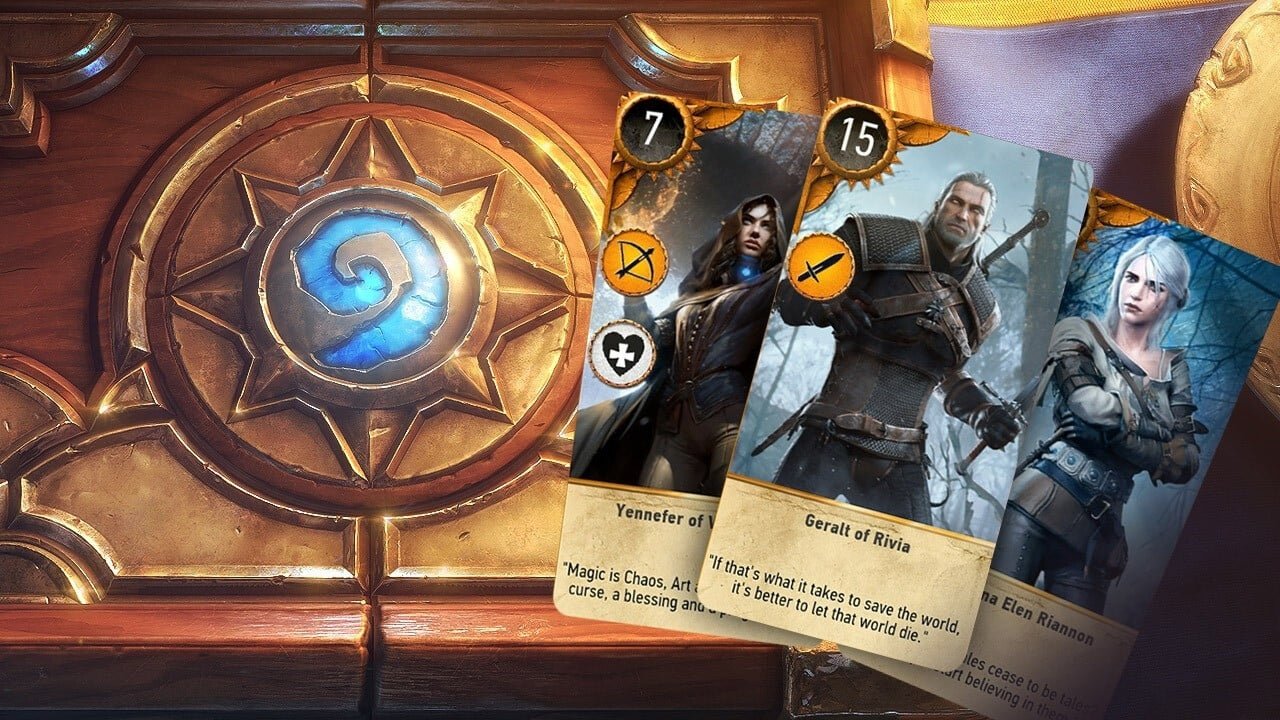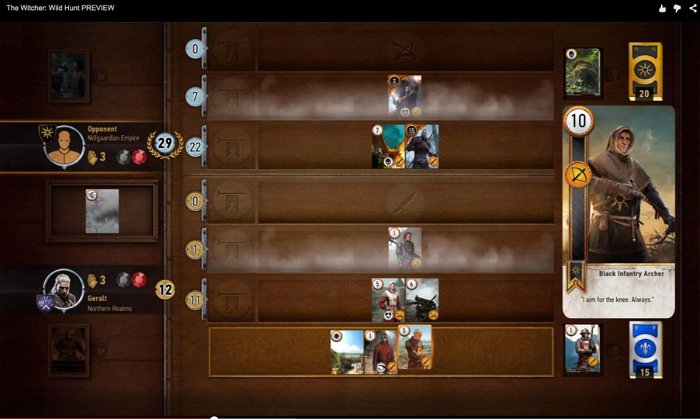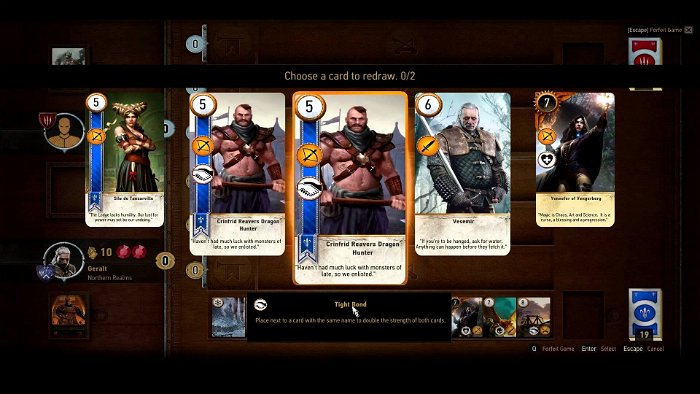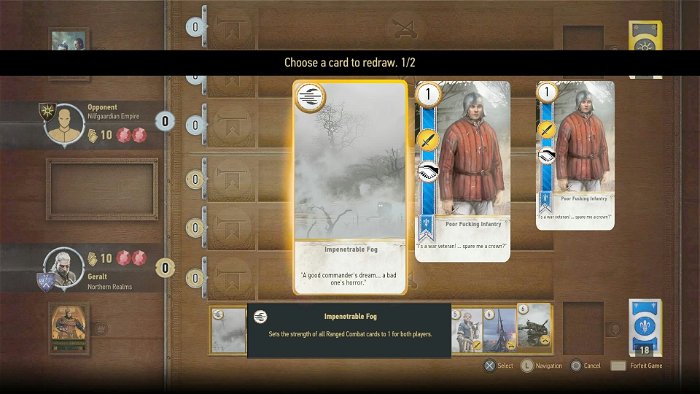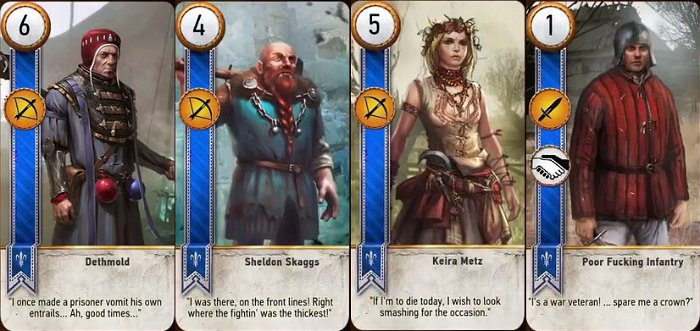
When I sat down to play The Witcher III: Wild Hunt, I fully expected to be drawn in by the series’ brutal world, morally ambiguous characters, and vicious combat. What I never expected, however, was how addicted I would become to “Gwent;” the collectible card game played by the many denizens of the Northern Kingdoms. Do not be fooled by the humble tutorial in the opening chapter, Gwent isn’t just another forgettable mini-game.
There was a time when mini-games weren’t as contrived and shallow as they are today. The proliferation of open world games today means developers are hungry for ways to fill those worlds with interesting distractions. Mini-games are a natural fit. But it feels like ages since mini-games aspired to only distract you for minutes—if that. Gwent, on the other hand, is the type of game that can absorb countless hours in your search for the perfect cards to build the perfect deck. It’s the kind of game that feels like it was built with tender care.
Gwent is deceptively simple. Two players play out a mock battle on a field divided on each side into three zones. Every unit card you play has a designated class: melee, ranged, or artillery. Each card in your army has a point value that designates how strong that card is, and by playing that card, you add its points to your overall total for that round. The player with the most points at the end of the round is declared the winner, earning a point in a match that is best two out of three.
Layers of depth are quickly added when players begin to collect more varied cards, including weather cards which don’t have a point value but instead can negate the point values of a specific class of cards on both sides of the deck. It’s an interesting system where sacrificing your own units can be, at times, beneficial if it means ruining more of your opponent’s cards. Furthermore, many cards have abilities like being able to resurrect cards in your graveyard, destroying cards on the board, or calling other cards of the same name from your deck immediately into play. Most cards also belong to a specific deck, such as Northern Army, Nilfgaard, Scoia’Tel, and Monsters, with each deck also having its own flavor, playstyle, and special abilities.
In the end, all of this results in a game that boasts a depth similar to Hearthstone and even Magic: the Gathering, if only on a mechanical level. But what really sends card game aficionados over the edge is how Gwent subverts many common themes in card games to create its own unique flow of battle.
A deck can be comprised of a minimum of 22 cards, yet players only draw 10 for the entire match. Those 10 cards must last you at least three rounds, with limited options for drawing more cards from your deck. This creates a game where proper pacing is far more important than brute strength. New players will want to flood their board with as many powerful cards as soon as they can, but a well-placed weather card from the enemy can lay even the strongest armies to waste. Overzealous card placement can leave you with nothing to play after the opening round.

it’s that kind of depth betrays a game far greater than its humble introduction within The Witcher III. Why CD Projekt Red doesn’t do more to showcase Gwent beyond the mere tutorial and a few associated quests is beyond me. Fans are already begging for mobile standalone versions of the game so they can challenge their friends, but it remains to be seen how CD Projekt Red will respond. Regardless, Gwent is a game that challenges the notion of mini-games and raises the bar going forward.
Card games have had a long tradition in role-playing games. Much of that tradition is thanks to Square Enix and Final Fantasy for pioneering such fond classics like Tetra Master and Triple Triad. Both mini-games have enjoyed standalone releases and implementations outside of their respective games. Perhaps most notable, is Final Fantasy XIV: A Realm Reborn, which recently incorporated Triple Triad into its gameplay with the game’s 2.4 content patch. Like The Witcher III, Final Fantasy XIV didn’t just bring Triple Triad into the game as a mere homage, but instead fleshed out Triple Triad into a realm-spanning collect-a-thon that could consume hundreds of hours for those devoted to collecting every card.
While it remains to be seen how much time Gwent can feasibly consume, what is immediately clear is that CD Projekt Red has succeeded in creating a game with a deep well of strategic depth to draw from. Perhaps, even better, is that Gwent is a game capable of being expanded on. Magic: the Gathering has built upon its core rules with decades of expansions, and Gwent feels every bit as capable of expanding in the same regard.
Previous Witcher games settled for distracting players with dice poker, but Gwent is a very clear indication that the studio is no longer content to just meet expectations. The Witcher III: Wild Hunt is as bold as role-playing games come, forging new paths in every conceivable direction.
For now, Gwent can enjoy the admiration of its growing fanbase, but whether CD Projekt Red will see the potential and look into expanding the game will take time. One thing’s for certain, Gwent is a game fully capable of existing beyond its little box within The Witcher III. Like sidekicks becoming heroes in their own right, Gwent can join the pantheon of mini-games like Geometry Wars and Triple Triad that have risen to stand shoulder to shoulder with the games that first implemented them.
